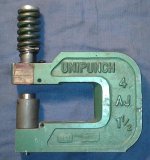So I need to figure out a way to punch a 5/8" hole in a 1.25" plastic cap (similar kind of cap that you would find on a jug of juice or soda bottle, etc.) The cap also has a soft poly-something gasket stuck in the top of the cap that needs to be punched with cap also. I need to punch a lot of them so I need something effective and efficient.
I have virtually no knowledge of presses, punches, or any other tools/machinery that might be used in such a way. If anyone could help me out, I'd be very grateful. As I have virtually no knowledge of this kind of work, please be specific and detailed! Thanks!
I have virtually no knowledge of presses, punches, or any other tools/machinery that might be used in such a way. If anyone could help me out, I'd be very grateful. As I have virtually no knowledge of this kind of work, please be specific and detailed! Thanks!


 )
)
